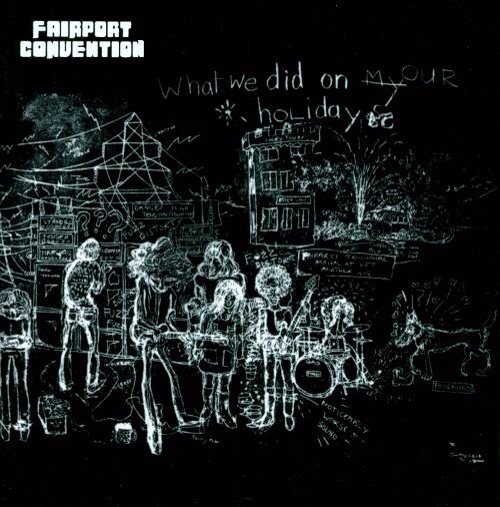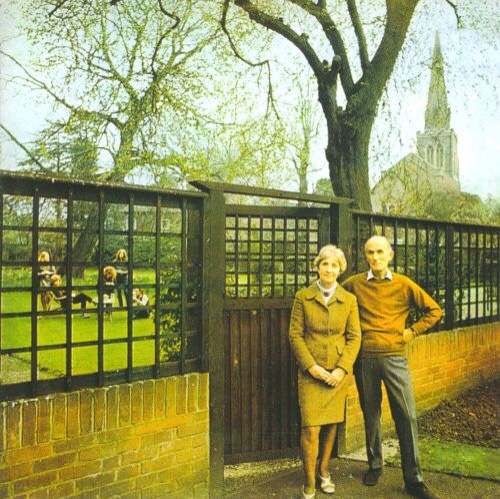Fairport Convention, the celebrated British folk rock group are due to play a venue near me very soon. I had considered going but when I discovered tickets are something along the lines of £25 I soon declined. I still cant get to grips with paying more than £1.99 to see a band, it’s ridiculous I know, especially in these days when legacy bands are basically topping up their pensions for a time when they simply can’t tread the boards anymore.
There is also the fact that I am a typical Fairport fan, grey hair, beard, pretty old. The concert would be full of people just like me and that’s a depressing thought. It didn’t have to be like this, I never set out to look like an aging folkie. It hit hard the other day when I found a picture of me on Facebook, taking part in a session. There I was with a bunch of old folkies sat in the back as usual clasping a melodeon. In fact it was only the latter detail that made me realise that this was not me at all but just another identikit folk musician in another town with another instrument.
The terrible irony is that I loved Fairport Convention, I still do but only up to the point that they switch their allegiances fully to folk rock. They made that commitment 47 years ago but my love of Fairport dates from the first four years of their existence.
The band were formed around the Muswell Hill area of North London by bassist Ashley Hutchings and guitarist Simon Nichol. They soon recruited 17 year old wiz kid guitarist Richard Thompson followed by drummer Martin Lamble and singer Judy Dyble. Personally I thought Dyble was great but the band soon felt the need to augment the line up further with a male singer Ian (iain) Mathews who unlike the rest was a professional singer from the North(well Scunthorpe)
The band were as hip as fuck, they played all the cool places in the summer of love and jammed with Hendrix. They were an ambitious and intelligent bunch of people who could be relied upon to seek out some hip Americans to copy, notably Joni Mitchell and Dylan. Already Richard Thompson was finding ways of playing the electric guitar in ways that avoided being a substandard copy of Buddy Guy.
The first Fairport album was a lost delight from the West Coast, there are shades of County Joe and the Fish and Jefferson Airplane but for me it’s actually better than those groups. Already Thompson was writing if not singing and the psychedelic ‘Lobster’ is one of his weirder songs. Dyble and Mathews voices mesh in a San Francisco way. If I had I time machine I would be programming it to the UFO club in 1967 when Fairport Convention were on.
Not long afterwards Dyble was out of the band taking her autoharp with her (actually according to some of the rare photographs Simon Nichol inherited it ) Apparently she had a tendency to sing sharp and was rather shy for a lead singer. Dyble was replaced by Sandy Denny, already a minor figure on the singer songwriter scene and for people of my generation one of the best singers ever. There followed two of the very best albums of all time, ‘What we did on out Holidays’ and ‘Unhalfbricking’. The former featured a photo of a blackboard that the band had written on prior to a gig. That says it all about the band for be that instead of snorting cocaine out of groupie‘s navels they were drawing an enormous cartoon depicting the band onstage. The album also marked the beginning of the first significant Richard Thompson songs (meet on the ledge) and a tentative verson of a traditional folk song ‘Nottm Town’ from whence Dylan had nicked the melody for ‘Masters of War’.

Unhalfbricking went one further featuring a Denny song that has slowly become a classic ‘who knows where the time goes’, one of those rare songs that says so much more than the actual lyrics and is a testament to the sensitivity of the playing of the whole band. Also present, and most significant in retrospect was the traditional ‘A Sailor’s Life’ where the band, now augmented by fiddler Dave Swarbrick embarked on a psychedelic exploration that now had its roots in England rather than The American West Coast.
Unhalfbricking also features, in retrospect the saddest album sleeve ever. The lives of the young people enjoying a summer’s afternoon on the lawn of Sandy Denny’s parents was about to be torn apart.

Travelling back from a late night gig the band’s van left the road. It;s probable that their roadie Harvey (prophetically portrayed in convict outfit on ‘what we did in our holidays’) had fallen asleep at the wheel. The van somersaulted dispensing passengers and gear over the British countryside. Sandy Denny had chosen to travel with her new boyfriend Trevor Lucas and Ian Mathews had left the group around ‘Unhalfbricking’. The rest of the band were still onboard though and sustained injuries rated between minor (Nichol) and significant (Hutchings). Worst of all two of them were dead, drummer Martin Lamble and passenger Jeannie Franklyn, at the time Thompson’s girfriend.
On any level this was a traumatic incident for any group of young people but Fairport had been the golden children of the London underground, their charmed lives were changed forever.
Healing physically if not psychologically the band reconvened at farley chamberlayne in Hampshire and photos taken at the time show they were still prone to a romp on the lawn. Dave Mattacks had joined as drummer and Dave Swarbrick was now a permanent member. Hutchings had been completely enthralled by Denny’s rendition of traditional British songs and was becoming obsessed with the idea of the band becoming a folk rock unit except folk rock was not even a thing yet.

The result of their labours was ‘Liege and Leif’, a thick dark slab of a record which has grown in status with each passing year. Some of the band thought this was an experiment, Denny for one didn’t want to go back to performing the same songs she had practically grown up with while Hutchings was at the other end of the spectrum desiring to dedicate his life to playing in tents at folk festivals. As a result of this tension both of them left the band. Hutchings was replaced by Dave Pegg, a mate of Swarbrick’s and a veteran of the surprisingly fertile Birmingham scene. It kind of marked a change from inspired amateur dabbling to professional presentation and, for me at least, the band became less interesting. As the band set the folk rock template I bailed out, I only own the first four record and only the first three survived the transition to CD..
Amazingly, in 1969 the band released these three classic records, what sort of work rate is that? They survived the departure of one of their singers and the death of their drummer. Creatively the band was on fire, it was as if music was pouring out of them. And then after that incandescent period two of the band quite almost as soon as they had released one of the most important records of all time. And the other amazing fact is that the middle of all this creativity no one got round to filming it, there are not videos of Denny with the band ( until she rejoined a few years later)
As the 70’s progressed the band became increasingly a vehicle for Swarbrick who was a fine fiddler but couldn’t sustain interest with his singing. Thompson left and eventually so did founder member Nichol. Sandy Denny ( and Trevor Lucas) joined for a while and by the mid 70’s Swarbrick was leading a motley crew of disparate musicians who were high on talent and low on purpose, in fact they were being referred to as Fairport Confusion by the press who never knew just who might turn up to a gig.
And round 1978 I finally got to see Fairport Convention.

Simon Nichol had rejoined as had Dave Pegg. Dave Mattacks was now doing very well as a session musician but Bruce Rowlands had replaced him. It was an evening of knockabout fun. Swarbrick must have managed to smoke a whole packet of fags onstage, at least one of them was wearing dungarees and I swear they sang a song about dogs arseholes! It wasn’t high art but I considered my £1.99 had been well spent.
The band split up soon afterwards but started to reform sporadically in the 80’s notably for their own Cropardy festivals which are now an annual highlight for the sort of people who look like me.
Now in their 70’s the band are probably as good now as any time in the last 30 years, its almost as if they’ve stopped trying to be good and have settled to be OK and very OK they are.
Not worth £25 though!
I paid £120 to see Fairport, and a number of other bands, at their Cropredy festival in August this year. The audience consisted of a large number of ‘old folkies’ (all wearing left-off bits of curtain – ‘where are all these people hiding,’ I remember thinking, ‘when I walk down the High Street’), but there were also a surprisingly large number of young ‘uns (possibly the oldies grandkids or maybe they were there of their own accord? Good for them.) The atmosphere was laid-back and friendly.
It was nice to see Fairport, but the highlight of the week-end for me was seeing Al Stewart – the acoustic set he did was fantastic.
My own preference for Fairport, was around the time of the Full House / Angel Delight era; and later when they produced Bonnie Bunch Of Roses.
I too, remember Simon Nicol singing about “dogs’ arse-holes hanging on a hook” around the time of late 70s; I think it might have been a fill-in for while the rest of the band re-tuned mid-session.
I won’t be going back to Cropredy next year, or any other year, but I will always have a little bit of Fairport playing in my head until I ‘up sticks’.
LikeLiked by 1 person
Thanks, I’m glad the dogs arseholes thing just wasn’t my feverish imagination. Cropredy is a weird do, plenty love. I caught the band this May which is only the third time I have seen them ( I had the Cropredy experience a few years back), it seems their fans have aged with them without them gaining any new but I have to say I was still quite impressed.
LikeLike